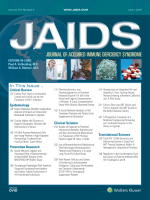Posted on December 01, 2015
Source: JAIDS Journal of Acquired Immune Deficiency Syndromes

Schrack, Jennifer A. MS, PhD; Althoff, Keri N. MPH, PhD; Jacobson, Lisa P. PhD; Erlandson, Kristine M. MD; Jamieson, Beth D. PhD; Koletar, Susan L. MD; Phair, John MD; Ferrucci, Luigi MD, PhD; Brown, Todd T. MD, PhD; Margolick, Joseph B. MD, PhD for the Multicenter AIDS Cohort Study
Background: Gait speed predicts functional decline, disability, and death and is considered a biomarker of biological aging. Changes in gait speed in persons aging with HIV may provide an important method of gauging health and longevity in an under assessed population. The objective of this study was to evaluate and quantify the rate of gait speed decline in HIV-infected (HIV+) men compared with HIV-uninfected (HIV−) men.
Methods: The study was nested in the Multicenter AIDS Cohort Study. The primary outcome was usual gait speed in meters per second measured between 2007 and 2013. Differences in the rate of gait speed decline and the incidence of clinically slow gait (<1.0 m/s) were assessed using multivariate linear regression models and Cox proportional hazards models, respectively.
Results: A total of 2025 men (973 HIV+ and 1052 HIV−) aged 40 years and older contributed 21,187 person-visits (9955 HIV+ and 11,232 HIV−) to the analysis. Average gait speeds at the age 50 years were 1.24 and 1.19 m/s in HIV− and HIV+ men, respectively (P < 0.001). In fully adjusted models, gait speed decline averaged 0.009 m/s per year after age 50 years (P < 0.001); this decline was 0.025 m/s per year greater in HIV+ men (P < 0.001). Moreover, HIV+ men had a 57% greater risk of developing clinically slow gait (adjusted hazard ratio = 1.57, 95% confidence interval: 1.27 to 1.91).
Conclusions: These findings indicate a faster rate of functional decline in HIV-infected men, suggesting greater risks of disability and death with advancing age.